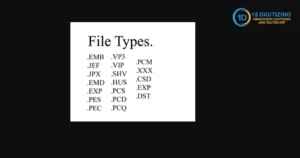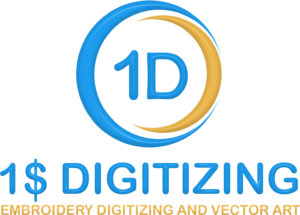Introduction of Embroidery Formats
Embroidery has evolved significantly with the rise of advanced machines and sophisticated software. Today, a significant aspect of this art lies in understanding embroidery formats, the backbone of machine functionality. These embroidery file formats dictate how your design is read and executed by different machines. With the variety of file types for embroidery accessible, knowing the foremost prevalent and broadly utilized ones is basic to seamless design execution and imaginative opportunity.
In this comprehensive guide, we are going examine the top 10 well-known embroidery formats, their compatibility, and their features to help you make educated choices for your machine embroidery digitizing projects.
Why Are Embroidery Formats Important?
Embroidery file types are computerized blueprints for your designs. Each file format contains nitty-gritty instructions, including stitch placement, thread color, stitch type, and density. The format you select decides how your embroidery machine deciphers the design. Choosing the wrong format could lead to errors or incomplete designs.
Some file formats are exclusive to specific machines, while others are universal and widely supported. Understanding their differences ensures that your designs translate perfectly from digital art to stitched reality.
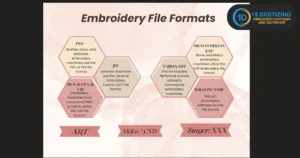
1. PES – Perfect for Brother and Baby Lock Machines
The PES embroidery file format is one of the most used formats for home embroidery machines. Exclusively compatible with Brother and Baby Lock machines, PES is favored for its ability to retain all essential design details, including stitch order and thread colors.
Key Features of PES Format:
Machine Compatibility: Brother, Baby Lock, and compatible machines.
Design Precision: Retains complex stitch patterns and thread color information.
Editing: Easily edited using popular digitizing software like PE-Design and Embrilliance.
PES is ideal for hobbyists and professionals, offering versatility and reliability for a wide range of projects.
2. DST – The Standard for Commercial Embroidery Machines
The DST file format is the industry standard for commercial embroidery machines, especially those manufactured by Tajima. Known for its simplicity and lightweight structure, DST files focus on stitch data without storing thread color information.
Why Choose DST?
Machine Compatibility: Used by Tajima, Barudan, and other commercial machines.
Lightweight: Suitable for designs requiring minimal file size.
Scalability: Ideal for mass production environments.
Although it lacks thread color data, its universal application makes DST a top choice for professional embroidery digitizing.
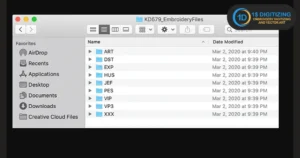
3. EXP – Designed for Bernina Machines
The EXP embroidery file format is tailored for Bernina machines. It provides high accuracy in stitch placement, making it a go-to option for intricate designs and advanced users.
Advantages of EXP Format:
Detailed Designs: Supports precise stitch patterns.
Software Support: Compatible with ArtLink and other Bernina-specific software.
Multi-Threaded Projects: Handles layered designs efficiently.
EXP files are a staple for Bernina users aiming to achieve flawless stitching and detailed artwork.
4. JEF – Exclusively for Janome Machines
Janome embroidery machines use the JEF file format, which is both user-friendly and highly functional. This format caters to beginners and seasoned professionals alike, offering robust features for different embroidery styles.
Key Benefits of JEF Format:
Machine Compatibility: Works seamlessly with Janome and compatible models.
Stitch and Color Data: Retains all critical design details.
Software Integration: Compatible with Janome’s Digitizer software.
For those invested in Janome machines, JEF is a reliable format for creating stunning embroidery designs.
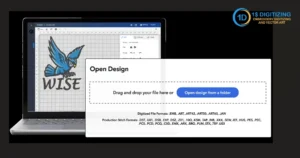
5. VP3 – The Choice for Husqvarna Viking and Pfaff Machines
The VP3 file format is designed for Husqvarna Viking and Pfaff embroidery machines. It is renowned for its advanced handling of large and complex designs.
Why Use VP3 Format?
High Resolution: Retains superior detail for intricate patterns.
Layered Stitching: Supports multi-color and multi-layered projects.
Software Compatibility: Works with PREMIER+ and other Viking software.
If precision and detail are priorities, VP3 is a must-have for Viking and Pfaff users.
6. XXX – Compucon and Singer Machines
The XXX embroidery file format is often associated with Singer and Compucon embroidery machines. Known for its straightforward usability, XXX files are ideal for basic to moderately complex custom embroidery designs.
Features of XXX Format:
Ease of Use: Suitable for beginners.
Broad Compatibility: Works with Singer and other legacy machines.
Customizability: Easily converted to more advanced formats.
For those using older Singer models, XXX remains a practical option.
7. HUS – Perfect for Husqvarna Viking Machines
The HUS format is another option for Husqvarna Viking embroidery machines. While not as detailed as VP3, it is lightweight and efficient for small to medium designs.
Benefits of HUS Format:
Streamlined Processing: Quick and reliable design execution.
Compact Size: Ideal for smaller projects.
Color Retention: Preserves thread color data accurately.
HUS is often preferred by users who require efficient design loading and execution without compromising on quality.
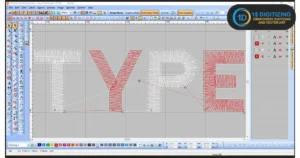
8. ART – A Premium Option for Bernina Machines
The ART embroidery file format is exclusive to Bernina machines and offers advanced functionality. It is ideal for intricate designs that require absolute precision.
Highlights of ART Format:
Exclusive Features: Optimized for Bernina-specific tools and features.
Multi-Layered Designs: Handles complex designs seamlessly.
Software Compatibility: Works with Bernina’s proprietary software.
For Bernina users, ART files unlock unparalleled capabilities for high-end embroidery projects.
9. PEC – A Versatile Option for Brother Machines
The PEC embroidery file format is an alternative to PES and is compatible with Brother machines. It offers similar functionalities but is often use for legacy projects.
Why Use PEC?
Stitch and Color Data: Stores critical design details.
Editing Ease: This can be converted to PES or other formats as needed.
Versatility: Supports older Brother machine models.
PEC remains a trusted format for those with older equipment or specific design needs.
10. SEW – Supporting Legacy Janome and Elna Machines
The SEW file format is tailored for older Janome and Elna machines. While not as commonly used today, it remains valuable for maintaining legacy equipment.
Key Features of SEW Format:
Legacy Support: Perfect for older embroidery machines.
Simple Design Execution: Handles basic to moderately complex designs.
Compact Format: Lightweight and efficient.
For users working with old machines, stitch ensures that designs are executed flawlessly.
How to Choose the Right Embroidery Format
Selecting the right file type for embroidery depends on your machine, design requirements, and software capabilities. Here are some tips to guide your choice:
Know Your Machine: Check your machine’s manual for supported file types.
Consider the Design Complexity: For intricate patterns, choose formats like VP3 or PES.
Leverage Software Capabilities: Ensure your digitizing software supports your desired format.
Conclusion
Understanding and using the correct embroidery file formats is a cornerstone of successful machine embroidery. From the universally popular DST format for industrial machines to the user-friendly JEF for Janome models, each format serves a unique purpose. Mastering these formats will help you achieve flawless designs, whether for personal projects or commercial production.
